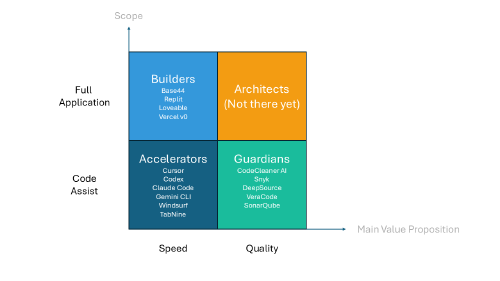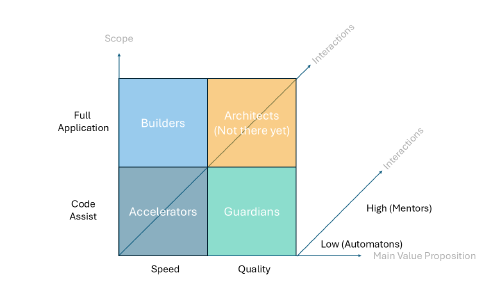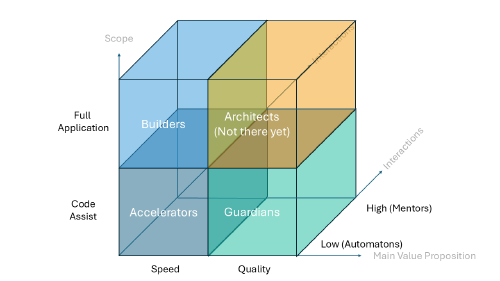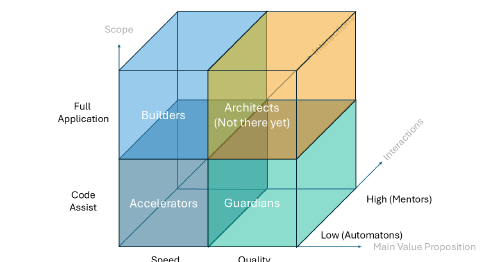How To Classify Tools That Use AI To Write Code?
- 9 minutes read - 1808 wordsCursor, Windsurf, Copilot, Vercel v0, Base44, Replit, Loveable, CodeCleaner AI, Claude Code, Google Gemini CLI, Open AI codex, these are just a few of the many AI-assisted coding tools available today.
The software development landscape is at the beginning of a period of profound transformations, driven by an explosion of new tools that are using Generative AI to write code faster and more efficiently.
The Problem
What began as a novelty has rapidly evolved into a near-necessity.
Developers workflow and the economics of software creation are changing to include AI-assisted coding.
We are also seeing a “Great Convergence” of features. Tool like GitHub Copilot or Cursor can both:
- Write your code and, if correctly prompted,
- Explain it.
A platform like CodeCleaner AI can both:
- Find a security flaw and,
- Help you fix it.
How can we navigate this and make sense of the landscape? Which tool is right for me? How do I choose the best tool for my team?
Simple, single-purpose labels (e.g., “Code Generator”, “Code Completion”, “Code reviewer”) are inadequate.
Classifications based on where a tool lives (e.g., “In-IDE Co-Pilot”, “Web-based”, “In the terminal”) also fail to capture the strategic reality of the market.
We need a new mental model to navigate this.
The Four Quadrant Framework
First, we can classify tools along two axes:
- Core Value Proposition (the “why”): the fundamental problem a tool solves:
- Developer Velocity - making me faster. The key metric is productivity.
- Code Integrity - making my code better and safer. The key metric is risk reduction.
- Scope of AI Intervention (the “how”): the primary unit of work that the AI performs:
- Code-Level Assistance - operates on existing code within a developer’s project, provides suggestions, fixes, and explanations for specific functions, files, or snippets.
- Application-Level Generation - create entirely new software from a high-level prompt, scaffolding entire applications or major components from scratch.
Plotting the market on these two axes reveals the four quadrants:

A Third Dimension: The Mentorship Axis
The Four Quadrants tell us what a tool does, but not how it interacts with the developer.
We also need a third, cross-cutting axis: the Mode of Collaboration (the “who” - automaton or mentor).

This axis classifies tools based on their philosophy of human-AI collaboration. What is the primary role of the AI in the interaction? Is the AI:
- An Automaton:
- The AI’s primary goal is to execute a task with maximum efficiency and minimal human intervention. Takes a command. Produce a result.
- The developer’s role is to issue the command and validate the final output.
- The core value is frictionless task completion.
- A Mentor:
- The AI’s primary goal is not just to complete a task, but to empower and upskill the developer in the process. It explains its reasoning, provides context, suggests alternatives, and engages in a dialogue.
- The developer’s role is to learn, question, and make informed decisions.
- The core value is developer empowerment and skill development.
A tool in any quadrant can lean towards being an Automaton or a Mentor, and many offer features that span this spectrum.
The Four Main Types of Tools
The Accelerators
Primary success metric is speed. Core Philosophy: To act as an AI pair programmer, making professional developers dramatically faster and more productive within their existing workflow.
Accelerators - Automaton-Leaning Features
The AI is acting as a silent, efficient typist. The primary interaction is accepting or rejecting a suggestion with a single keystroke.
The AI suggests code, and the developer hits “Tab” to accept. The interaction is transactional and built for pure velocity.
Examples:
- GitHub Copilot The core code completion of GitHub Copilot turns natural language comments into code and completes lines or entire functions, epitomizing the automaton model of speed.
- Tabnine Tabnine’s code completion is one example of an automaton, learning a team’s specific coding patterns to provide suggestions to accelerate development.
- Cursor An AI-first code editor, the core functionality is built around generating and refactoring code instantly based on prompts. The focus is on maximizing developer velocity through direct code manipulation.
Accelerators - Mentor-Leaning Features
These features still aim for speed but build in moments for learning and comprehension. They can pause to explain a complex piece of code or document a function on command.
These features empower the developer to not just use the code, but to understand it.
Examples:
- The GitHub Copilot
/explainchat command, which can break down a selected piece of code, shifting from a pure automaton to a mentor that helps developers understand complex logic. - Tabnine’s “Code Explain and Onboarding Agent” feature helps developers understand existing codebases, acting as a guide and mentor for new team members.
- Claude Code can map and explain entire codebases. We can use it to explain project architecture and onboard new developers.
The Guardians
- Primary success metric: risk reduction.
- Core Philosophy: To act as an automated expert reviewer, ensuring that all code (whether human- or AI-written) is correct, secure, and compliant.
Guardians - Automaton-Leaning Features
These tools find a vulnerability and fix it with a single click, abstracting away the details of the remediation. The goal is to reduce the vulnerability count as efficiently as possible.
Examples:
- Snyk’s “one-click fix pull requests” that automatically generate the necessary code changes to patch a dependency.
- DeepSource’s “AutoFix” engine is another example of this automated remediation philosophy.
Guardians - Mentor-Leaning Features
These tools find a vulnerability and then teach the developer why it’s a problem, how the fix works, and how to avoid it in the future. They prioritize code and security literacy.
Examples:
- CodeCleaner AI with its interactive loops designed to help developers understand, challenge, and validate code improvements suggested by the AI.
- Snyk Learn provides context-specific lessons on vulnerabilities, teaching developers secure coding practices directly within their workflow.
- [Veracode’s] platform offers eLearning and Security Labs, providing on-demand training and interactive labs to upskill developers in secure coding practices.
- SonarQube provides deep explanations for its findings, helping developers understand the root cause of quality and security issues.
The Builders
- Primary success metric: time-to-market.
- Core Philosophy: To dramatically reduce the time and complexity of creating a new application, transforming a high-level idea into a functional software artifact.
Builders - Automaton-Leaning Features
These are the “black box” application generators.
The user provides a prompt, and a complete, functional application emerges.
The internal workings are hidden to maximize ease of use for non-technical users.
Examples:
Pure no-code platforms where the user never sees or touches the underlying code.
- Base44 allows users to build fully-functional apps from natural language prompts without needing to see or write code, acting as a pure application automaton.
Builders - Mentor-Leaning Features
These tools generate applications but do so transparently. A user can inspect the output, learn from the patterns, and eventually take over the code for customization.
The generated codebase itself becomes a learning tool, empowering a less-experienced user to understand how a full-stack application is constructed.
Examples:
- Vercel v0 generates React, Tailwind CSS, and Shadcn UI components from a text prompt, but allows users to “eject” the code, learn from it, and customize it.
- Lovable generates standard React and Tailwind CSS code, providing a transparent, editable codebase that serves as a learning tool for full-stack development.
- Replit “Vibe Coding” allows users to create applications through natural language, but provides a full IDE to see, learn from, and modify the generated code.
The Architects
- Primary success metric: verifiable adherence to rules.
- Core Philosophy: To generate entire applications that are guaranteed to meet stringent, pre-defined standards for security, compliance, and architectural correctness.
Architects - Automaton-Leaning Features
This would be the next frontier. And, at the time of writing this (July 2025), this is still an emerging category.
These tools take a set of compliance rules (e.g., HIPAA, FedRAMP) and a high-level prompt, then generates a fully compliant application skeleton that requires only final validation.
The Architects represents the desired future for software development in regulated and mission-critical industries.
Architects - Mentor-Leaning Features
These are, as of July 2025 still emerging.
These tools guide the user through the process of architecting a compliant application, explaining the rationale behind each decision and how it meets specific regulatory requirements.
They are walking a developer through architectural decisions, explaining the trade-offs of different patterns (e.g., microservices vs. monolith), and helping them design a compliant and scalable system from first principles.
Strategic Implications and Market Dynamics
This three-dimensional framework helps clarify the competitive landscape. It also explains the market’s convergence that we are seeing in the AI coding assistant space.
The primary battle is not between quadrants, but within them, with the Mentorship Axis emerging as a key differentiator.
When Accelerators like GitHub Copilot are adding Guardian features (security scanning), it’s not to become a Guardian. It is to make their generated code more trustworthy and to strengthen their core value proposition of velocity.
Similarly, when a Guardian like Snyk adds Accelerator features (AI-powered fixes), it’s not to become a code generator. It is to make its core value proposition of integrity more efficient and actionable for developers.
The Mentorship Axis - A Key Differentiator
As AI tools become commoditized, a tool’s collaborative philosophy is a growing source of competitive advantage.
For enterprises focused on upskilling their workforce, a Mentor tool that improves developer capabilities over time may offer a higher long-term ROI than a pure Automaton, even if the latter offers slightly faster task completion in the short term.

Recommendations for Evaluation
This framework provides a clear checklist for evaluating and procuring AI developer tools.
Identify Your Primary Quadrant
First, determine the core problem you need to solve.
- If your primary goal is to increase development speed and reduce repetitive coding tasks, you need an Accelerator.
- If your primary goal is to reduce security risk, improve code quality, and ensure compliance, you need a Guardian.
- If your primary goal is to rapidly prototype and build new applications from scratch, you need a Builder.
Determine Your Desired Collaboration Model
Next, decide on your strategic priority for human-AI interaction.
- If your goal is maximum, frictionless efficiency for senior developers, lean towards tools with strong Automaton features.
- If your goal is to empower your team, improve skills, and foster a culture of learning and quality, lean towards tools with strong Mentor features.
Evaluate and Assess
Use this 3D framework to evaluate tools.
A tool may have a core competency in one quadrant but offer valuable secondary features that lean towards another quadrant or collaboration model.
Assess the complete package based on your specific needs.
For example, when choosing an Accelerator, you might prioritize one with strong Mentor features to help onboard junior developers more quickly.
